
Oxygen
Sensor
Wiring for O2 sensor with thermistor (-TM)
red High side of differential channel (positive
lead for sensor)
black Low side of differential channel (negative
lead for sensor)
clear Analog ground (for sensor)
green Single-ended channel (Positive lead for
thermistor)
orange Analog ground (negative lead for thermistor)
white Excitation channel (excitation for thermistor)
Yellow 12V port (positive lead for heater)
Blue Ground (negative lead for heater)
Using the Sensor
1. Connect the O2 lead wires to a good quality volt meter or a datalogger. See
page 3 for wiring instructions.
2. To calibrate, measure the millivolt output of the sensor in a well ventilated
area. The O2 concentration in the atmosphere is 20.95 %. Do not breathe
on the sensor as exhaled breath is much lower. The output signal of the
sensor is approximately 50 mV for the soil sensor and 12 mV for the fast
response sensor in ambient air at sea level. Calibration establishes the
exact multiplier to convert the mV reading to % O2 .
3. Divide 20.95 by the mV output value. If the output was exactly 12.0 mV the
multiplier would be 1.746 (20.95 / 12.0). This is the multiplier to convert mV
to % O2. This multiplier will be correct for your elevation, current barometric
pressure, current humidity, and current temperature.
4. Install the multiplier value in your datalogger program.
5. Recalibrate as needed when changes in pressure, temperature, or humidity
occur.
Owners Manual
Model: O2S
-D or -F
-S or -FR
-TM or -TC
Wiring for O2 sensor with thermocouple (-TC)
red High side of differential channel (positive
lead for sensor)
black Low side of differential channel (negative
lead for sensor)
clear Analog ground (for sensor)
green 12V port (positive lead for heater)
white Ground (negative lead for heater)
Yellow High side of differential channel (positive
lead for thermocouple)
red Low side of differential channel (negative
lead for thermocouple)
Oxygen Sensor
This sensor is a galvanic cell type oxygen sensor that
measure oxygen gas (O2) in air. It has a lead anode, a gold
cathode, an acid electrolyte, and a Teon membrane. The
current ow between the electrodes is proportional to the
oxygen concentration being measured. An internal bridge
resistor is used to provide a mV output. Unlike polargraphic
oxygen sensors, they do not require a power supply. The
accompanying temperature sensor and resistance heater
(inside the same housing) do require power as listed on page
8. The internal micro-heater serves to prevent condensation
on the sensing membrane in high humidity applications.
The mV output responds to the partial pressure of oxygen in
air. The standard units for partial pressure are kPa. However,
gas sensors that respond to partial pressure are typically
calibrated to read out in mole fraction of the gas in air, or units
of moles of oxygen per mole of air. These units can be directly
converted to % O2 in air, or ppm O2 in air. The concentration
of oxygen in our atmosphere is 20.9476 %, and this precise
percentage has not changed for decades. It is also constant
across changing temperatures or pressures. This allows for
precise calibration of the instrument.
Additional information and a sample datalogger program
for Campbell Scientic Dataloggers can be found at our
website at:
http://www.apogee-inst.com/oxygen_sensor.htm
1
For the most stable reading, the
sensor should be used with the sensor
opening facing down. This facilitates the
best contact of the electrolyte with the O2
sensing elements.
model O2S-F-S-TC
23

Specications
435-792-4700
www.apogeeinstruments.com
Humidity Changes
The graph below shows an example of humidity dependency.
The sensor chemistry is not inuenced by humidity, but its output
decreases because O2 is displaced by water vapor molecules in
the air. The effect of humidity is larger at warmer temperatures
because there is more water vapor in the air.
Sensor dimensions 3.15 dia. by 6.85 cm long. 1/2” X 20 threaded end
Mass 175 g
Range 0 to 100% O2
Accuracy < 0.01% O2 drift per day
Repeatability ±0.001% O2 (10 ppm)
Input power 12V power for heater, 5V excitation for thermistor
Operating environment 0 to 50 °C
Cable 3 meters of shielded, twisted 6-conductor cable
with Santoprene casing, ending in pigtail leads;
Warranty 1 year parts and labor
Zero Offset
The mV output in ultra-pure nitrogen gas (0.000 % oxygen) is
typically ± 0.05%. Precise measurements of hypoxic and anaerobic
conditions can be made by making a periodic zero calibration of the
sensor with ultra-pure nitrogen gas. The zero offset for each sensor
is highly reproducible and should be entered into the programming
after a zero- test.
Life Expectancy
The life expectancy of the sensor is expressed in %-hours as
follows:
[Oxygen Concentration (%) x Exposure Time (hours)]
Accordingly, the life of the Apogee Fast Response Oxygen
Sensor (-FR) is 900,000 %-hours or approximately 5 years of
continuous use (at 21% oxygen at 20 ˚C). Life expectancy for the
Apogee Soil Sensor (-STD) is 1,800,00 %-hours, or approximately
10 years.
Storage Temperature
The life of the sensor can be extended by storage at a lower
temperature. For example a sensor stored at 0 ˚C will have a life
expectancy approximately twice that of a sensor stored at 20 ˚C.
The absolute minimum storage temperature is -20 ˚C. Below that
temperature the electrolyte will freeze. Maximum storage temperature
is 60 ˚C.
Shock And Vibration
The sensor is resistant to 2.7 G of shock. However, vibration may
inuence the sensitivity of the sensor and should be minimized.
O2S D or F S or FR TM or TC
Diffusion Head (D)
1.375” tall,
1.375” dia.,
125 mesh screen
creates air pocket
Soil (S)
Output: ~50 mV at 20.95% O2
Signal Decrease: <0.2% annually
Life Expectancy:
10 years continuous use
Response time: 60 seconds
Thermistor (TM)
Datalogger Channels:
1 differential and
1 single-ended
(Recommended for best
accuracy.)
Flow Through (F)
3.5 long by 3.5 cm dia.
1/8” Barbed adapters
for hose connections
Fast (FR)
Output: ~12 mV at 20.95% O2
Signal Decrease: 4% annually
Life Expectancy:
5 years continuous use
Response time: 12 seconds
Thermocouple (TC)
Datalogger Channels:
2 differential
(Requires a thermocouple
reference.)
For use in high humidity, such as in
soil, remove the head and take the
calibration measurement over water
in a sealed container as shown at
right.
Effects on Output
Inuence From Various Gases
The sensor is unaffected by CO, H2, and various acidic gases
such as CO2, H2S, NOX, SOX. However, the Teon membrane
used in the sensor may be damaged by ozone.
Temperature Sensitivity
By itself, the uncorrected mV output of the galvanic cell
would follow changes of the absolute temperature. A 3 °C
change at room temperature (about 25 °C), would change
the output by approximately 1 %. The internal thermistor
or thermocouple provides data on the current temperature
so its effect can be corrected according to the ideal gas law
(PV = nRT).
Pressure Changes
A change in barometric pressure changes the amount of
oxygen available to the sensor and therefore changes what
mV output correlates to oxygen’s atmospheric constant of
20.95 %. To eliminate this possible error, simply re-calibrate
or incorporate Apogee’s barometric pressure sensor, model
BPS.
BPS 1001
7 NOV 2006
Apogee Inst.
Model BPS
45
6
-
 1
1
-
 2
2
apogee INSTRUMENTS O2S-TC Owner's manual
- Category
- Motorcycle Accessories
- Type
- Owner's manual
Ask a question and I''ll find the answer in the document
Finding information in a document is now easier with AI
Related papers
-
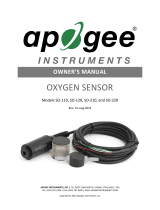 apogee INSTRUMENTS SO-120 Owner's manual
apogee INSTRUMENTS SO-120 Owner's manual
-
 apogee INSTRUMENTS SO-421 Owner's manual
apogee INSTRUMENTS SO-421 Owner's manual
-
 apogee INSTRUMENTS O2M-D Owner's manual
apogee INSTRUMENTS O2M-D Owner's manual
-
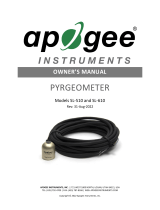 apogee INSTRUMENTS SL-510-SS Owner's manual
apogee INSTRUMENTS SL-510-SS Owner's manual
-
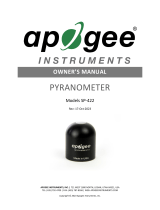 apogee INSTRUMENTS SP-422-SS Owner's manual
apogee INSTRUMENTS SP-422-SS Owner's manual
-
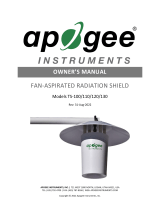 apogee INSTRUMENTS TS-100 Owner's manual
apogee INSTRUMENTS TS-100 Owner's manual
-
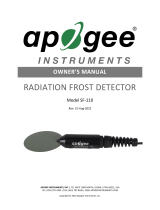 apogee INSTRUMENTS SF-110 Owner's manual
apogee INSTRUMENTS SF-110 Owner's manual
-
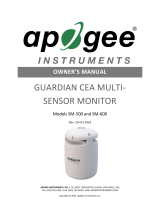 apogee INSTRUMENTS SM-600 Owner's manual
apogee INSTRUMENTS SM-600 Owner's manual
-
 apogee INSTRUMENTS IRR-P Owner's manual
apogee INSTRUMENTS IRR-P Owner's manual
-
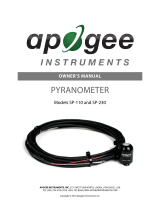 apogee INSTRUMENTS SP-110-SS Owner's manual
apogee INSTRUMENTS SP-110-SS Owner's manual
Other documents
-
Apogee SO-220 User manual
-
Apogee SO-110 Owner's manual
-
Apogee SO-421 User manual
-
Apogee MO-200 Owner's manual
-
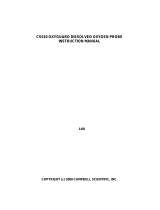 Campbell Manufacturing Oxyguard CS510-L User manual
Campbell Manufacturing Oxyguard CS510-L User manual
-
Campbell Scientific OXYGUARD TYPE III CS512 User manual
-
Rosemount 7003D O2 Monitor-Rev K Owner's manual
-
Campbell Scientific CR10 Owner's manual
-
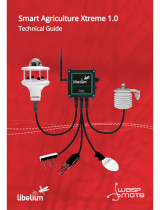 Libelium Smart Agriculture Xtreme 1.0 Technical Manual
Libelium Smart Agriculture Xtreme 1.0 Technical Manual
-
Campbell Scientific CR7 Owner's manual













